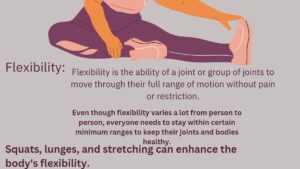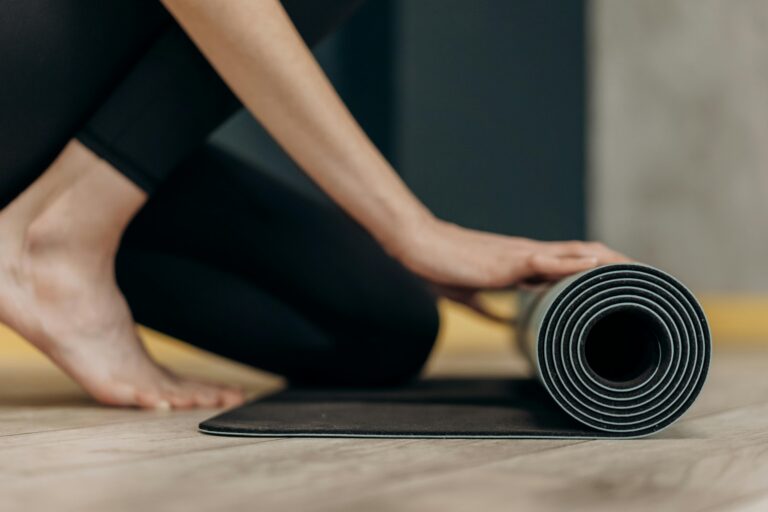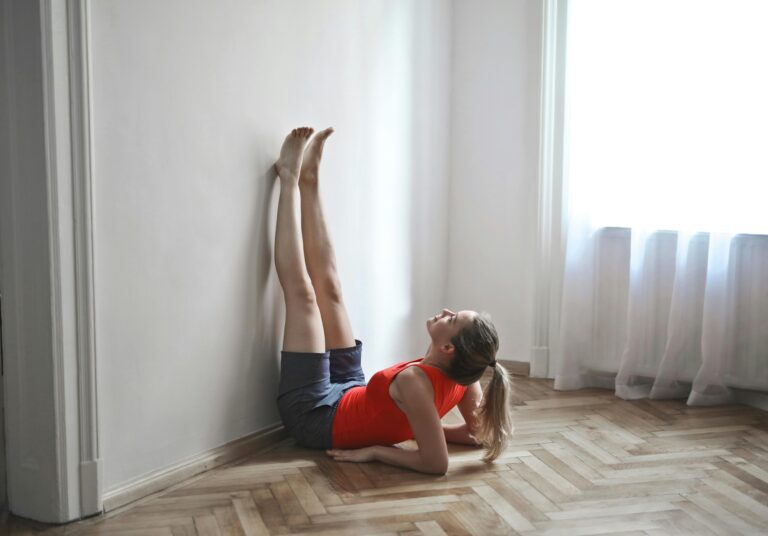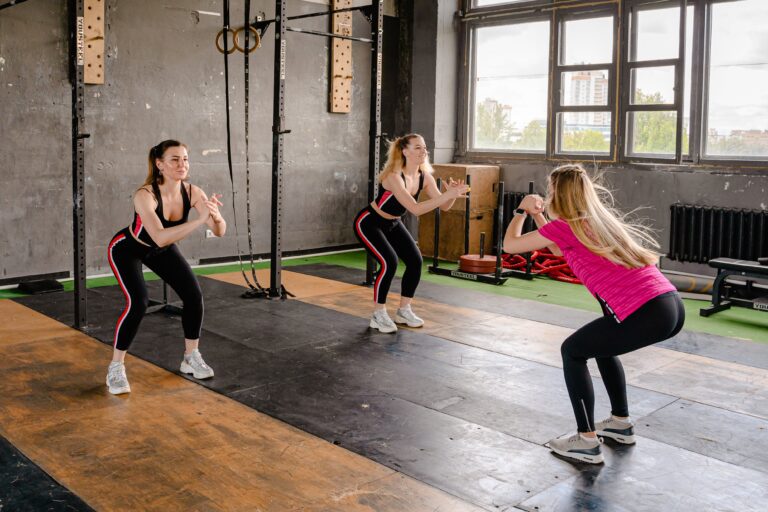10-minute Daily Exercise Routine to Keep You Fit
Certainly! Here’s a simple yet effective 10-minute daily exercise routine that targets various muscle groups and helps in keeping you fit:
-
Warm-up (1-2 minutes):
- Start with light cardio like marching in place, jumping jacks, or jogging on the spot to raise your heart rate and warm up your muscles.
-
Bodyweight Squats (1 minute):
- Stand with feet shoulder-width apart.
- Lower your body by bending your knees, keeping your back straight.
- Go as low as comfortable or until thighs are parallel to the floor.
- Push through your heels to return to the starting position.
-
Push-ups (1 minute):
- Assume a plank position with hands shoulder-width apart.
- Lower your body by bending elbows until your chest nearly touches the ground.
- Push back up to the starting position, keeping your body in a straight line.
-
Plank (1 minute):
- Get into a plank position with forearms on the ground, elbows aligned under shoulders.
- Keep your body in a straight line from head to heels, engaging your core muscles.
- Hold this position for one minute, focusing on keeping good form and breathing steadily.
-
Lunges (1 minute):
- Stand with feet together, step forward with one leg and lower your body until both knees are bent at a 90-degree angle.
- Push back to the starting position and alternate legs.
-
Mountain Climbers (1 minute):
- Get into a plank position with hands under shoulders.
- Alternate bringing knees towards your chest in a running motion while keeping your core engaged.
-
Jumping Jacks (1 minute):
- Stand with feet together and arms by your sides.
- Jump while spreading your legs and raising your arms above your head.
- Return to the starting position by jumping back to the initial stance.
-
Cool Down and Stretching (1-2 minutes):
- Finish with some gentle stretching exercises targeting major muscle groups, holding each stretch for around 15-30 seconds.
Remember,
It’s crucial to perform exercises with proper form to prevent injury. Modify the intensity or number of repetitions based on your fitness level. Also, if you have any health concerns, consult a healthcare professional before starting a new exercise routine.
Understanding the Importance of Regular Exercise
Regular exercise plays a pivotal role in maintaining overall health and well-being. Its importance spans across various aspects of physical, mental, and emotional wellness:
Physical Benefits of Regular Exercise:
- Weight Management: Exercise helps in burning calories, controlling weight, and reducing body fat. It also boosts metabolism, aiding in weight management.
- Improves Cardiovascular Health: Regular physical activity strengthens the heart, improves circulation, and reduces the risk of heart diseases, stroke, and high blood pressure.
- Enhances Muscle Strength and Endurance: Engaging in resistance training and exercises increases muscle strength, endurance, and bone density, reducing the risk of osteoporosis and improving posture.
- Boosts Immune Function: Exercise can bolster the immune system, reducing the risk of illnesses and improving the body’s ability to fight infections.
- Increases Energy Levels: Regular physical activity improves stamina and energy levels, reducing fatigue and promoting better sleep quality.
Mental and Emotional Benefits of Regular Exercise:
- Reduces Stress and Anxiety: Exercise triggers the release of endorphins, neurotransmitters that help in reducing stress, anxiety, and depression while enhancing mood.
- Improves Cognitive Function: Regular exercise enhances brain function, improves memory, concentration, and overall cognitive abilities.
- Boosts Self-Esteem and Confidence: Achieving fitness goals through regular exercise can boost self-esteem and confidence levels.
- Better Sleep Quality: Regular physical activity can promote better sleep patterns and improve sleep quality.
Long-term Health Benefits:
- Reduces Chronic Disease Risks: Regular exercise can lower the risk of chronic diseases like type 2 diabetes, certain cancers, and metabolic syndrome.
- Promotes Longevity: Studies have shown that a consistent exercise routine is linked to a longer lifespan and a reduced risk of premature death.
Psychological Benefits:
- Enhances Mood: Exercise stimulates the release of endorphins, leading to feelings of happiness and relaxation.
- Alleviates Symptoms of Depression: Physical activity can be as effective as medication or therapy in alleviating symptoms of mild to moderate depression.
Understanding and acknowledging the importance of regular exercise can motivate individuals to incorporate physical activity into their daily routines, leading to a healthier and more fulfilling lifestyle.
Why Choose Home Workouts?
Choosing home workouts can offer several advantages, making them an appealing option for many individuals. Here are some reasons why people opt for home workouts:
Convenience and Accessibility:
- Flexibility in Schedule: Home workouts allow you to exercise at any time that suits your schedule without the constraints of gym hours. You have the freedom to work out early in the morning, late at night, or whenever it’s most convenient for you.
- No Commute Needed: Eliminating travel time to and from the gym saves time and allows you to start your workout immediately, reducing potential barriers to exercise.
- Privacy and Comfort: Some people prefer the privacy of their homes for workouts, avoiding any self-consciousness or distractions that may occur in public gyms.
Cost-Effectiveness:
- Saves Money: Home workouts eliminate the need for gym memberships or expensive fitness classes, saving money in the long run.
- Minimal Equipment Required: Many effective home workouts can be performed with minimal or no equipment, utilizing bodyweight exercises or affordable fitness tools like resistance bands or dumbbells.
Customization and Personalization:
- Tailored Workouts: You have the freedom to choose workouts that suit your preferences, fitness goals, and skill level, creating a personalized routine.
- Variety and Diversity: With online resources, apps, and videos, there is a vast array of workout routines available, allowing you to switch up exercises and prevent boredom.
Comfort and Familiarity:
- No Waiting for Equipment: At home, you don’t need to wait for equipment or machines, which can be a common issue in crowded gyms.
- Freedom in Attire: You can wear whatever attire you feel comfortable in without feeling judged or restricted by a gym dress code.
Family and Accessibility:
- Inclusion of Family Members: Home workouts provide an opportunity for family members to join in, promoting a healthy lifestyle for everyone.
- Accessibility for Beginners: For those new to fitness, home workouts offer a comfortable environment to start without feeling intimidated by a gym setting.
Adaptability:
- Adaptable to Space: You can customize workouts according to the available space in your home, whether it’s a small room, living area, or outdoor space.
- Weather and External Factors: Home workouts are not affected by weather conditions, allowing for consistency in exercise routines regardless of outdoor conditions.
Ultimately, the decision to choose home workouts depends on personal preferences, convenience, and the ability to maintain a consistent exercise routine that aligns with your fitness goals and lifestyle.
The 10-Minute Daily Exercise Routine
Absolutely! Here’s a quick yet effective 10-minute daily exercise routine that targets various muscle groups and boosts overall fitness:
-
Warm-up (1 minute):
- Start with light jogging or marching in place to raise your heart rate and warm up your muscles.
-
Bodyweight Squats (1 minute):
- Stand with feet shoulder-width apart.
- Lower your body by bending your knees, keeping your back straight.
- Rise back up to the starting position, engaging your glutes and thighs.
-
Push-ups (1 minute):
- Assume a plank position with hands slightly wider than shoulder-width apart.
- Lower your body by bending your elbows until your chest nearly touches the ground.
- Push back up to the starting position.
-
Plank (1 minute):
- Get into a plank position, resting on your forearms and toes.
- Keep your body in a straight line from head to heels, engaging your core muscles.
- Hold this position for one minute, maintaining proper form and breathing steadily.
-
Jumping Jacks (1 minute):
- Stand with feet together and arms by your sides.
- Jump while spreading your legs and raising your arms above your head.
- Return to the starting position by jumping back to the initial stance.
-
Mountain Climbers (1 minute):
- Get into a plank position with hands under shoulders.
- Alternate bringing knees towards your chest in a running motion while keeping your core engaged.
-
Lunges (1 minute):
- Stand straight with feet together.
- Step forward with one leg, lowering your body until both knees are bent at 90 degrees.
- Push back to the starting position and switch legs.
-
High Knees (1 minute):
- Stand in place and jog, lifting your knees as high as possible.
- Swing your arms to add momentum and engage your core.
-
Bicycle Crunches (1 minute):
- Lie on your back, lift your legs, and bend them at a 90-degree angle.
- Bring your elbows to the opposite knee while extending the other leg.
-
Cool Down and Stretch (1-2 minutes):
- Finish with gentle stretching exercises, focusing on major muscle groups like hamstrings, quadriceps, calves, shoulders, and back. Hold each stretch for 15-30 seconds.
Remember to maintain proper form throughout the exercises, and adjust the intensity or modify exercises based on your fitness level and comfort. This routine offers a full-body workout in a short span, promoting strength, flexibility, and cardiovascular health.
Making the Most Out of Your Home Workouts
Making the most out of your home workouts involves a combination of planning, commitment, and maximizing the resources available. Here are some tips to help you optimize your home exercise routine:
1. Set Clear Goals:
- Define specific fitness goals that you want to achieve through your workouts. Whether it’s weight loss, muscle gain, increased flexibility, or improved overall fitness, having clear objectives will guide your exercise routine.
2. Create a Dedicated Space:
- Designate an area in your home solely for exercising. It doesn’t need to be large but should provide enough space for your movements. This helps in establishing a routine and mindset for your workouts.
3. Plan and Schedule Workouts:
- Set a regular workout schedule and stick to it. Treat your workout sessions as appointments to ensure consistency. Consider the time of day that works best for you and fits into your daily routine.
4. Variety in Workouts:
- Incorporate diverse exercises to target different muscle groups and prevent boredom. Utilize bodyweight exercises, resistance training, yoga, HIIT (High-Intensity Interval Training), cardio, and flexibility exercises to keep your routine interesting.
5. Use Online Resources:
- Take advantage of numerous online platforms offering workout videos, apps, and live streaming sessions. These resources provide structured routines, guidance, and motivation, catering to various fitness levels and preferences.
6. Invest in Equipment:
- Consider investing in basic workout equipment based on your preferences and space available. Items like resistance bands, dumbbells, stability balls, or a yoga mat can add versatility to your workouts.
7. Stay Consistent:
- Consistency is key to seeing progress. Even if you’re short on time, sticking to a regular routine helps maintain fitness levels and progress toward your goals.
8. Challenge Yourself:
- Gradually increase the intensity or duration of your workouts to continuously challenge your body. This progression prevents plateaus and helps you advance in your fitness journey.
9. Focus on Form:
- Prioritize correct form and technique in every exercise to prevent injuries and maximize the effectiveness of your workouts. Quality movements yield better results than quantity alone.
10. Track Progress:
- Keep a workout journal or use apps to track your progress. Documenting your workouts, achievements, and improvements can boost motivation and help you stay on track.
11. Recovery and Rest:
- Allow your body sufficient time to recover between workouts. Incorporate rest days into your routine to prevent burnout and promote muscle recovery.
By incorporating these strategies into your home workouts, you can optimize your exercise routine, stay motivated, and achieve your fitness goals effectively.
How to Stay Motivated to Exercise at Home
Staying motivated to exercise at home can sometimes be challenging, but there are several strategies you can implement to maintain your enthusiasm and consistency:
1. Set Clear and Achievable Goals:
- Define specific and realistic fitness goals. Whether it’s improving endurance, losing weight, gaining muscle, or simply staying active, clear goals provide direction and motivation.
2. Create a Consistent Routine:
- Establish a regular workout schedule. Consistency is key to forming a habit. Designate specific times for exercise, making it a part of your daily or weekly routine.
3. Find Activities You Enjoy:
- Engage in exercises and activities that you genuinely enjoy. Whether it’s dancing, yoga, HIIT workouts, cycling, or any other form of exercise, having fun makes it easier to stick with your routine.
4. Mix Up Your Workouts:
- Incorporate variety into your workouts to keep things interesting. Try new exercises, switch up routines, or explore different workout styles to prevent monotony.
5. Set Up a Dedicated Workout Space:
- Designate a specific area in your home for exercise. Having a dedicated space creates a workout environment that can boost motivation.
6. Use Fitness Apps or Online Resources:
- Explore fitness apps, workout videos, or online classes. These resources provide structured workouts, guidance, and often a sense of community or accountability.
7. Workout with a Friend or Virtually:
- Exercise with a friend virtually or connect with workout buddies. Having a virtual exercise partner can increase motivation and make workouts more enjoyable.
8. Reward Yourself:
- Establish rewards for achieving your fitness goals or sticking to your workout routine. It could be anything from a relaxing bath, a favorite meal, or something you enjoy.
9. Track Your Progress:
- Keep track of your workouts, progress, and achievements. Seeing improvements over time can be incredibly motivating.
10. Practice Self-Compassion:
- Be kind to yourself on days when motivation is low. It’s okay to have off days; what matters is getting back to your routine without being too hard on yourself.
11. Set Short-Term Milestones:
- Break down your long-term goals into smaller, achievable milestones. Celebrate these milestones as you progress.
12. Get Creative and Stay Flexible:
- Modify workouts, try new exercises, or adapt to changes in your schedule or preferences. Being adaptable and flexible in your approach helps maintain motivation.
13. Visualize the Benefits:
- Remind yourself of the positive impacts of regular exercise on your physical health, mental well-being, energy levels, and overall quality of life.
By implementing these strategies and finding what works best for you, you can boost your motivation and consistency with home workouts, leading to a more fulfilling fitness journey.
Safety Measures While Exercising at Home
Exercising at home is a fantastic way to stay fit, but it’s crucial to ensure your safety to prevent injuries. Here are some safety measures to consider while working out at home:
1. Warm-Up and Cool Down:
- Always start your exercise routine with a warm-up to prepare your muscles and gradually increase your heart rate. Similarly, cool down with stretching exercises at the end of your session to reduce muscle soreness and promote flexibility.
2. Use Proper Equipment:
- If using exercise equipment, ensure it’s in good condition and properly maintained. Follow manufacturer instructions for assembly and usage to prevent accidents.
3. Choose the Right Space:
- Select a safe and clear area in your home for exercising. Remove any obstacles or hazards that could cause tripping or falling during workouts.
4. Maintain Proper Form and Technique:
- Focus on maintaining correct form and technique in every exercise to prevent injuries. Improper form can strain muscles or lead to joint issues.
5. Start Slowly and Progress Gradually:
- Especially if you’re new to exercising or returning after a break, start with low-intensity workouts and gradually increase the intensity or duration to prevent overexertion.
6. Stay Hydrated:
- Keep yourself hydrated before, during, and after workouts. Drink water regularly to avoid dehydration, particularly during intense exercise sessions.
7. Listen to Your Body:
- Pay attention to how your body feels during exercise. If you experience pain, dizziness, or discomfort, stop immediately and seek medical advice if necessary.
8. Use a Spotter if Needed:
- For certain exercises like heavy lifting or advanced movements, having a spotter or someone nearby can provide assistance and ensure safety.
9. Be Cautious with New Exercises:
- If trying new exercises or routines, start with a lower intensity or seek guidance from fitness professionals to ensure proper execution and safety.
10. Check Workout Environment:
- Ensure proper ventilation and lighting in your workout space. Good ventilation helps prevent overheating, while adequate lighting reduces the risk of accidents due to poor visibility.
11. Wear Appropriate Attire:
- Choose comfortable and appropriate workout attire and footwear that provide support and stability for your workouts.
12. Be Mindful of Children and Pets:
- If you have children or pets at home, ensure they are in a safe area away from your exercise space to avoid accidents.
13. Consult a Professional:
- If you have any underlying health conditions or concerns, consult a healthcare professional or fitness trainer before starting a new exercise regimen.
Prioritizing safety while exercising at home helps prevent injuries and ensures a more enjoyable and effective workout experience. Always prioritize your well-being and take necessary precautions to stay safe during your fitness routines.
Incorporating Exercise into Your Daily Routine
Incorporating exercise into your daily routine is an excellent way to ensure regular physical activity becomes a habit. Here are some tips to seamlessly integrate exercise into your daily life:
1. Schedule Exercise:
- Treat exercise as an important appointment. Set aside specific times in your daily schedule dedicated to working out.
2. Choose Activities You Enjoy:
- Engage in activities you find enjoyable. Whether it’s dancing, cycling, swimming, hiking, or playing a sport, selecting activities you like increases the likelihood of sticking with them.
3. Start Small:
- If you’re new to exercising or have a busy schedule, begin with short sessions. Even 10-15 minutes of exercise multiple times a day can add up and contribute to your overall fitness.
4. Be Consistent:
- Consistency is key. Aim to exercise regularly, whether it’s daily or several times a week. Establishing a routine helps make exercise a natural part of your day.
5. Set Realistic Goals:
- Define achievable fitness goals. Break them down into smaller milestones to track your progress and maintain motivation.
6. Make Use of Breaks:
- Use short breaks during your workday for quick exercises. Stretch, take a brisk walk, or do a few bodyweight exercises to keep active.
7. Incorporate Exercise in Daily Activities:
- Opt for stairs instead of elevators, walk or cycle for errands if possible, or do household chores vigorously to increase physical activity throughout the day.
8. Wake Up Earlier:
- Consider waking up a bit earlier to fit in a morning workout routine. This can set a positive tone for the day and ensure your exercise is done before daily commitments arise.
9. Stay Active Throughout the Day:
- Look for opportunities to move more. Take short walks, do squats while waiting, or perform desk exercises to stay active.
10. Involve Others:
- Exercise with family or friends. Incorporating physical activities together can make workouts more enjoyable and create a support system to stay motivated.
11. Keep Exercise Gear Handy:
- Keep your workout clothes, shoes, or any equipment you use in a visible and easily accessible place to eliminate any barriers to getting started.
12. Be Flexible:
- Be flexible with your exercise routine. If you miss a scheduled session, don’t get discouraged. Adjust and make it up later or the next day.
13. Monitor and Celebrate Progress:
- Keep track of your achievements and celebrate milestones. Recognizing progress can boost motivation to continue exercising regularly.
By integrating exercise into your daily routine, it becomes a habit rather than a chore. Find what works best for you, stay consistent, and prioritize your health and well-being through regular physical activity.
Conclusion
In conclusion, incorporating regular exercise into your daily life brings numerous benefits for your physical, mental, and emotional well-being. Whether you choose to work out at home, in a gym, or in the outdoors, making fitness a part of your routine offers immense advantages.
Exercise plays a pivotal role in maintaining a healthy weight, improving cardiovascular health, enhancing muscle strength and endurance, and reducing the risk of chronic diseases. It also positively impacts mental health by reducing stress, anxiety, and depression while boosting mood, cognitive function, and self-esteem.
When it comes to integrating exercise into your daily routine, consistency is key. Set realistic goals, prioritize activities you enjoy, and establish a regular schedule. Whether you’re engaging in structured workouts, incorporating movement into daily tasks, or making use of breaks for physical activity, finding ways to stay active throughout the day is crucial.
Remember, safety is paramount. Prioritize proper form, use appropriate equipment, and listen to your body to prevent injuries while exercising.
Ultimately, exercise should be viewed as a holistic approach to enhancing your overall quality of life. It’s not just about physical fitness but also about feeling energized, improving mood, and enjoying a healthier lifestyle. By making exercise a habitual part of your daily routine, you’ll reap the long-term benefits and pave the way for a healthier, happier you.







